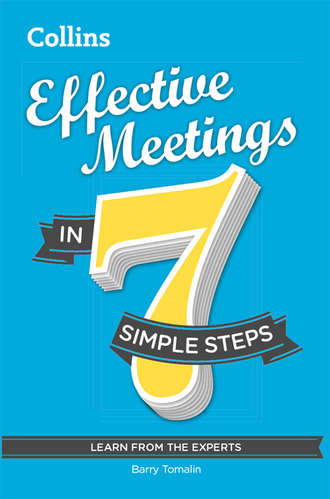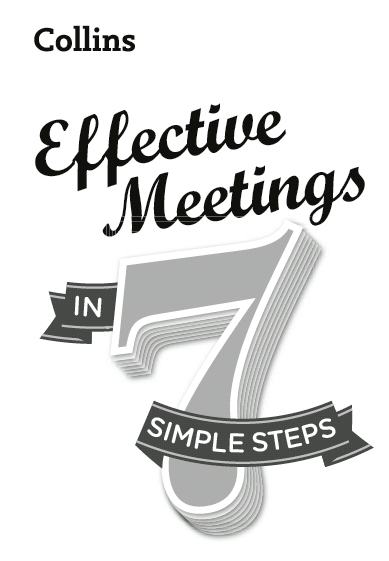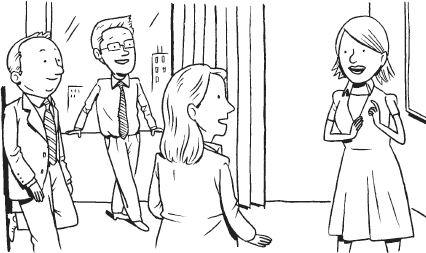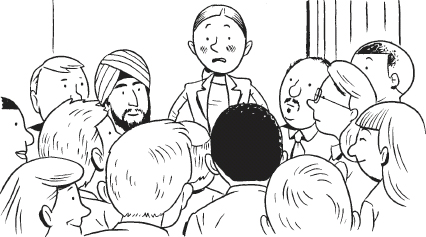
Полная версия
Effective Meetings in 7 simple steps


Contents
Step 1: Organise people, places and times
Step 2: Prepare useful documents
Step 3: Participate with impact
Step 4: Host virtual meetings
Step 5: Use informal meetings wisely
Step 6: Adapt to meeting dynamics
Step 7: Run efficient, effective meetings
Keep Reading
About the Author
Copyright
About the Publisher
Step 1
ORGANISE PEOPLE, PLACES AND TIMES
‘Did we make a decision in there?’ —US executive after a meeting in the UK
Five ways to succeed
Be clear why the meeting is necessary.
Only relevant people should attend the meeting.
Book meeting rooms and facilities early.
Keep to an agreed date and time.
Send regular reminders to delegates.
Five ways to fail
Be unclear about the purpose of the meeting.
Don’t check and chase up attendance.
Don’t check layout and organisation of the meeting room.
Don’t send out invitations.
Ignore the paperwork (agenda, minutes).

Welcome to the world of meetings. This is the activity which will take up the majority of your time at work. Up to 60 per cent, in fact. An estimated four million hours are spent in meetings every day in the UK alone.
So now you’ve realised this is likely to be your major work activity you need to know how to organise your time. The best way to do this is to use the time-honoured framework of five W’s and an H: Why, What, Who, When, Where and How. Let’s start with Why.
Why so many meetings? Good question. Meetings are like tribal gatherings. Work groups share a practical and emotional need to get together and discuss things and to exchange information.
You may not have much choice about which meetings you attend, but even meetings you think are irrelevant may be useful. You get the opportunity to observe how meetings work. Remember, don’t just focus on the topic, focus on the mechanics of the meeting (how it’s constructed and run) as well.
Meetings are the lifeblood of any organisation. They are the way information is shared in the group. They are the prime way of giving the work group a sense of belonging. This is why it’s worth:
limiting the number of meetings
having more focused meetings
having shorter meetings.
Let’s unpack each item on that list.
Limit the number of meetings
Attend four two-hour meetings back to back and you’ll know why you need to limit the number of meetings. Your whole working day has gone – and you haven’t done any desk work yet. So you’re already behind. In addition, by the end of the fourth meeting, what you discussed in the first meeting is a distant memory.
If you’re lucky enough to be able to choose which meetings to attend, consider these criteria. Prioritise meetings which:
directly concern you
have information you need to know about
cover responsibilities you have to report on
contain people you need to meet or talk to
deal with things which interest you or you can learn from.
For all the rest, take a view.
Get a copy of the meeting invitation and the agenda. Does it meet one of your criteria above? If yes, try and go. If not, ask your line manager if you need to attend.
Learn to discriminate. Decide which meetings will be important or helpful to you. For the others, explain your workload to your line manager and ask if you can be absent. Ask yourself constantly: ‘What is my purpose for being here? Could I use this time better, doing something else?’
Most meetings can be summarised over the coffee machine. If you miss a meeting, ask a colleague: ‘Did I miss anything important?’
If you did miss something important, get a copy of the minutes. If necessary and appropriate, follow up with your own views.
Types of meetings
Obviously, not all meetings are the same. The type of meeting will depend on its function. Let’s look at some of them.
Tribal gatherings
These are fairly rare. They tend to be semi-public occasions and involve the paramount chief and various sub-chiefs. Each clan in the tribe is involved in praise songs and ‘death to our enemy’ chants, awards are handed out and there is some hospitality on hand. If you’ve attended an annual school prize-giving or sports day you’ll know what we’re talking about. In a company it’s usually called the AGM (Annual General Meeting), new product launch, or something like that. Why go? You go for the jamboree and the hospitality. It’s also a good chance to network, and if you’re to be honoured with a prize like ‘employee of the year’, it’s probably worth a look-in.
Weekly or monthly updates
These are usually project team and departmental meetings. Their function is to update on activities, check progress against deadlines, allocate responsibilities, troubleshoot problems and make sure everyone knows what they are supposed to be doing. Why go? You need to attend these. They’re important. If you can’t attend, make sure people know beforehand. ‘No shows’ are not well viewed. It’s a sign of disinterest or failure of responsibility. Neither are recommended qualities for promotion. So remember: if you can’t go, let the chair know. Beforehand.
Performance reviews
Performance reviews are another type of meeting. You often have to prepare paperwork, and sometimes the outcome of this meeting affects your salary, bonuses and training opportunities.
Brainstorms
These are single topic discussions with an open agenda where all ideas are welcome. The rule (not always observed) is that any idea, no matter how far-fetched, is worth voicing. The aim is to get ideas for future action, often in new areas of company development. Why go? They’re lively and fun and they help you get a feeling for other members of the group: how they think; what their priorities are. If you have something useful to contribute it’s also a great way to make an impression. One word of advice: never speak first. You’re better off keeping your powder dry until you know which way the wind is blowing. Then when you do speak, in favour or in opposition to what others are saying, you’ll make a stronger impact.
General meetings
If these don’t sound relevant to you, avoid them whenever you can. They can range from how to economise on coffee machines to saving paper or other office matters. Enough said.

Shorter meetings
Let’s practise what we preach and have a brief summary of shorter meetings. Here are three ideas:
Meeting at 10.10 Most people expect ten o’clock. They wander in a few minutes late, get coffee or tea, find their seat, complain that there are no biscuits, and catch up on gossip. So the first ten minutes or so is actually wasted time. That’s why some meeting organisers start their meetings at an odd time. They start at ten minutes past ten, ignore latecomers and don’t recap for them. They get on with the agenda and finish when they say they will. If there is anything not discussed, they do it in a private meeting later or put it back to the next meeting.
Stand-up meetings That’s right. No one sits down. After half an hour or less, people are sagging – a great way to shorten a meeting, though not very comfortable.

Timed agenda Some meeting organisers put a duration against each point on the agenda, e.g. holiday time announcement (5 mins). This used to be very popular but has fallen out of favour now. Still useful, though, if only as an indicator.
If you think short meetings are impossible, look at the agenda of the President of the United States: Affairs of State may be concluded in ten minutes. No time for chat there.
Other meetings
Not all meetings take place in an office. If you work in a factory or department store, team meetings and staff announcements will often be held on the factory or sales floor. How are they different? Most meetings will be shorter. Most people will be standing up. They will usually be run by the department head, team leader or, maybe, trade union official.
The atmosphere is likely to be much more informal. People will just stand around the speaker. Once the announcement is made, people can ask questions. Then, when it’s over, everyone simply goes back to work.
In many factories and department stores, team ‘huddles’ are popular. These are informal meetings at the beginning or end of the day to remind the team of important points and boost morale.
There’s a last type of meeting that takes place in public. This is when senior members of staff address the troops on more general policy issues. These might take place in the cafeteria or in another public space. Do go. It might be your only chance to see the boss in person!

Meetings start with an invitation. The invitation is usually an email, sent round to people to say the meeting will take place. The invitation will normally state:
Date
Time (start and finish)
Location (room/building, check the size/capacity of the room)
Participants in the meeting
Topic (what the key aim of the meeting is, e.g. management meeting, conference planning, work allocation on the shop floor, customer service procedure, etc.)
Contact person (the person arranging the meeting)
If the agenda is finalised, it’s a very good idea to attach it to the invitation.
See Step 2 for more on invitations.


One of the key questions in any meeting is who should attend. There is a golden rule: as few as possible. And only those relevant to the outcome. Allowing everybody in is rarely effective in a meeting. You end up with dozens of ideas, hundreds of disagreements, no decisions and no clear way forward.
What are the outcomes of this approach?
time wasted
disaffected people
a demotivated department
It’s far better to decide what you want to achieve and who you think will help you achieve it, as well as those who might oppose it, though you need to listen to them. They often think of things you forget or warn you of possible dangers. Get these people in the meeting and focus on them.
How many people should attend? Research suggests that the optimum number of people in any meeting is five or seven: an odd number of participants allows a majority view to be reached. Many directors hold pre-meetings, almost chats, with trusted colleagues (and opponents) to review options and strategies before taking the issue to the larger meeting.

As you’d expect, if we spend 60 per cent of our time in meetings, there’s a lot of research into the right time for the meeting. Believe it or not, it varies. Most people will argue 10 or 11 a.m., when people are fresh. Almost everybody agrees that 2 p.m. after lunch is not the ideal time, but many meetings are held at 4 or 5 p.m. and they work quite well as ‘end of day’ team round-ups.
But you have to check availability times. As an example, the contract hours of the British employees in a French company in London were 8 a.m. to 5.45 p.m. The French would arrive at about 9.30, have a decent lunch from 12.45 to 2 p.m. and then leave the office around 7 or 7.30 p.m. As a result, they held their team meetings at 6 p.m.
This was like a French red rag to a British bull. This wasn’t just inconsiderate. It was a plot to make the British stay late at the office or cut them out of the decision-making loop. Office politics at its worst!
In fact, it was just a mistake. The French simply didn’t think. Once they realised the problem, they brought the team meeting forward to 4.30. Harmony reigned once again.
Punctuality is important in UK business. It’s important to be on time for meetings. If you think you might be late, always phone. Say you will be a bit later than you need. It’s much better to call and say, ‘I’ll be 20 minutes late’, and arrive earlier.
There are lots of examples like the French one, especially in companies with employees from different countries. ‘Who’s holding a meeting on my national day?’ ‘Who wants me to work on Sunday?’ (Not uncommon in Middle Eastern companies, where the holy day is Friday.) ‘Who wants me to go to a meeting at six o’clock in Ramadan?’ Sensitivity to issues like these helps employees feel considered and makes them more willing to come to meetings.
Normally, meetings conform to the holiday conventions of the UK. However, in our increasingly multinational working environment, it’s important to acknowledge others’ festivals and celebrations. The Chinese New Year is a good example of this.
Finding out about alternative dates can be a challenge. A good way to organise a meeting is to use a time chart.
Name Date 6th June Time 11.00 a.m. Date 7th June Time 11.00 a.m. Date 17th June Time 11.00 a.m. John * * * Hilary Pia BarryThe time chart is a table with names of invitees, dates and time. The organiser circulates it to colleagues. Notice there is an asterisk against the three dates. This indicates that the organiser, John, is free. The others do the same and when there is a day where all the slots are filled, then that is the day of the meeting. Simple but effective. Most computers have programs designed to help you arrange meetings and view people’s availability.
What happens if the spaces aren’t filled by everyone? Try again. It may take two or three attempts.

Where to hold a meeting poses two problems. One is whether to hold it inside or outside the office. The other is room and layout.
Office or elsewhere?
Most people think the right place to hold a meeting is around a table in an office. But meetings can take place anywhere. Some take place in the break-out areas in offices (the more informal areas with sofas and bean bags). See Step 5 for more information on informal meetings. Others take place in hotel lobbies or in restaurants over lunch or dinner. There are also away-days that are purposely arranged so they are off-site, i.e. away from the office, often in a business centre, so that people can get away from their day job and think about bigger picture issues.
If the groundwork for a meeting is done in a more relaxing environment, the formal bit, the confirmation, if you like, can be done in the office.
The office isn’t always the best place to start a series of meetings. It is usually the best place to finish them.
One of the key advantages of meetings outside the office is that participants are not so likely to get sucked into everyday office business. For example, if training sessions are held in the office training room there is a constant temptation to nip back to the office to check messages and make phone calls during the breaks. Obviously, participants can still access messages on their mobiles or laptops but off-site training means the interruptions will be fewer and briefer.
Meeting room organisation and layout
Dedicated meeting rooms should be OK for your meeting. But do check. They may be festooned with wires for conference calls or have computers on every desk.
Check the room you’ve booked is the right size and has enough chairs. And also check it doesn’t have too many chairs. Twenty chairs round a table when you have a meeting of five may make the place feel a bit empty. A bit like a restaurant with too many waiters and no guests. Check what’s in the room and around the walls. Is there anything you’d prefer your meeting attendees not to see? Also check the facilities. Is the space clean? Are the rubbish bins empty? Is the whiteboard clean? Is there a flipchart? Do you need data projection facilities?
When you’ve got your room, check the layout. Different kinds of layouts work for different kinds of activity. See here for the different layouts.
Boardroom
When you see the US government around the table in the White House in Washington DC or the Cabinet room at Number 10 Downing Street, the British Prime Minister’s residence and office in London, you’re looking at a boardroom layout. It’s good for limited discussion and creating a collective atmosphere.
The leader or convenor of a meeting is often called the chair (a unisex term).
Here’s a useful tip. If you want to get noticed in a meeting, make sure you are within the eyeline of the meeting leader. Just opposite or slightly to the right or left facing them is probably best.
Circle
Circles are for togetherness and for exchange. People in a circle, without tables, are favoured by ‘self-development’ groups. It’s supposed to encourage the exchange of personal information in a more relaxed environment. Going back to our meetings-as-tribal-gatherings analogy, American Indian pow-wows (discussions) were traditionally held in a circle. Traditional African village discussions are held in a circle under a tree in the village ‘square’, often with the leader in the middle holding a shell or other symbol giving him/her the right to speak. The Roman Senate sat in a circle and the United Nations and the EU debating chambers each form a semi-circle. Circles and semi-circles stress togetherness. Rows facing each other stress opposition – hence the layout of the British House of Commons.
Horseshoe
The horseshoe also encourages discussion, but also allows more space and freedom. Horseshoes work well for brainstorming and open discussion and have the advantage that all participants can see each other and address each other, with no one in a superior position.
Cabaret
Cabaret layouts work well for meetings where there are 12 or more participants, and they are seated around tables for three or four, a bit like tables in a nightclub – hence the name cabaret. A cabaret layout allows for lots of group work and reporting back.
Theatre
For large groups, sitting in rows might be the best way to proceed. It’s difficult to have group discussion in a theatre layout though. It’s best for listening to a presentation and asking and answering questions afterwards (Q&A).
Facing rows
Avoid this one if you can. It promotes opposition, as mentioned earlier. The British parliamentary system is based on government versus opposition. So it’s noisy and, in a fairly friendly British way, antagonistic.
The same occurs in business, but it’s not always friendly. Sometimes, this layout is dictated by the shape of the room and the number of attendees. The danger is that if people are opposite each other, they will naturally sit with those they agree with and opposite those they don’t.
As an example: a firm had contractual difficulties with one of its affiliates. A meeting was arranged to try to resolve the problem. Unfortunately, the meeting room had a table with two rows of chairs facing each other. The contractor and her team sat on one side and the affiliate and his team on the other. The atmosphere was stiff and cold. Points of agreement were difficult to find.
Then the contractor had a brainwave. She suggested they take a break, and during the break she changed the meeting room. The new room had a round table! Immediately, there was a more positive atmosphere, and after more discussion both sides reached an agreement.


